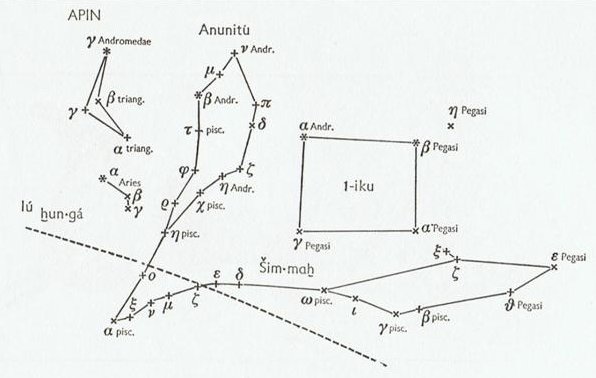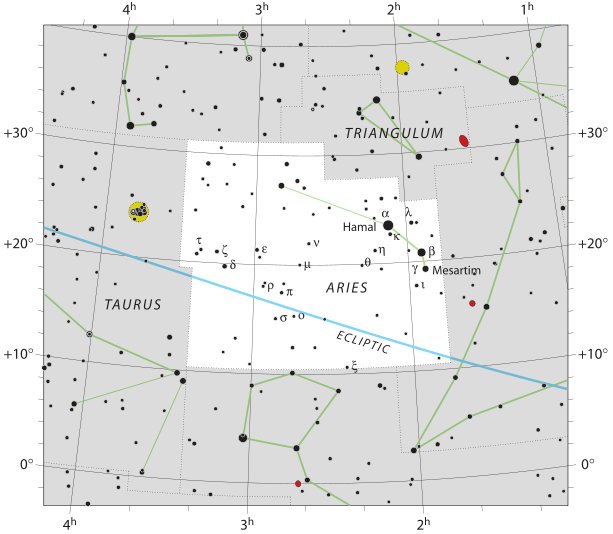From the beginning of line Cb2 (from Tau-ono) to the end of side b there are 348 - 24 = 324 (= 12 * 27) glyphs (days):
The creator of the text could have meant there was a season of rain (te ua) connected with Cb2-4, in the day after 3-14 (π, MARCH 14) when Porrima had culminated at midnight: ... This ritual takes place at midnight on the twenty-fifth of April and continues each night until the rains arrive ...
Once upon a time and north of the equator there could have been so much rain that the ground was flooded and a boat (Arab zaurak) became necessary. 26 days later was Phakt (α Columbae), the single explorer sent out by Noah in order to search for dry land. According to Manuscript E there once upon a time had been 7 explorers sent out by Hau Maka in order to search for Easter Island, but this was south of the equator.
... Utnapishtim is spry enough to tell [Gilgamesh] in great detail the story of the Deluge. He tells how Enki-Ea has warned him of Enlil's decision to wipe out mankind, and instructed him to build the Ark, without telling others of the impending danger. 'Thus shalt thou say to them: (I will ... go) down to the apsu and dwell with Ea, my (lor)d.' He describes with great care the building and caulking of the ship, six decks, one iku (acre) the floor space, as much for each side, so that it was a perfect cube [a sign of Saturn], exactly as Ea had ordered him to do. This measure '1-iku' is the name of the Pegasus-square, and the name of the temple of Marduk [the spring sun god] in Babylon, as is known from the New Year's Ritual at Babylon, where it is said: 'Iku-star, Esagil, image of heaven and earth.' ... Esagila is 1-iku - the Pegaus-square between the two Fishes that ruled the hibernal solstice during the Age of Gemini ...
Should we locate April 25 (115) at heliacal Zaurak, we have to transform day 74 (MARCH 14) to a precessional position corresponding to 64 - (115 - 74) = 41 days later than the time of Taurus. 64 - 41 = 23, with Achernar at 0h:
... We can perceive the gap in Cb2-6 as an illustration of the gap here forced upon between the upside down sky bowl (right) and the world below - receiving the benefits of rain and beams from the Sun. South of the equator November was a spring month corresponding to May in the north. ... The four males and the four females were couples in consequence of their lower, i.e. of their sexual parts. The four males were man and woman, and the four females were woman and man. In the case of the males it was the man, and in the case of the females it was the woman, who played the dominant role. They coupled and became pregnant each in him or herself, and so produced their offspring. But in the fullness of time an obscure instinct led the eldest of them towards the anthill which had been occupied by the Nummo. He wore on his head a head-dress and to protect him from the sun, the wooden bowl he used for his food. He put his two feet into the opening of the anthill, that is of the earth's womb, and sank in slowly as if for a parturition a tergo. The whole of him thus entered into the earth, and his head itself disappeared. But he left on the ground, as evidence of his passage into that world, the bowl which had caught on the edges of the opening. All that remained on the anthill was the round wooden bowl, still bearing traces of the food and the finger-prints of its vanished owner, symbol of his body and of his human nature, as, in the animal world, is the skin which a reptile has shed ... In essence the central element in Cb2-6 is a tapa mea (red Sun light cloth) type of glyph with 8 'Tree Feathers', 4 of them p.m. ('males') and 4 of them a.m. ('females').
... Ta'aroa sat in his heaven above the earth and conjured forth gods with his words. When he shook off his red and yellow feathers they drifted down and became trees ... 0h at the time of Achernar corresponded to FEBRUARY 8 - i.e. 324 days after the preceding 0h - at the time of the Bull:
From nakshatra Spica to heliacal Achernar there were 4 nights and from there to the end of side b on the C tablet there was a further week:
MARCH 25 (84) at heliacal Sheratan is a good fit - it was the date Julius Caesar had used for spring equinox. Hamal at glyph 392 (= 14 * 28) could have been considered as 'the first climbing bird' and then Sheratan would have been a manu kake erua. 14 * 26 = 364. ... Brown associates it {Hamal] with Aloros, the first of the ten mythical kings of Akkad anterior to the Deluge, the duration of whose reigns proportionately coincided with the distances apart of the ten chief ecliptic stars beginning with Hamal, and he deduces from this kingly title the Assyrian Ailuv, and hence the Hebrew Ayil; the other stars corresponding to the other mythical kings being Alcyone, Aldebaran, Pollux, Regulus, Spica, Antares, Algenib, Deneb Algedi, and Scheat ...
|
|||||||||||||||||||||||||||||||||||||||||||||||||||||||||||||||||||||||||||||||||||||||||||||||||||||||||||||||||||||||||||||||||||||||||||||||||||||||||||||||||||||||||||||||||||||||||||||||||||||||||||||||||||||||||||||||||||||||||||||||||||||||||||||||||||||||||||||||||||||||||||||||||||||||||||||||||||||||||||||||


















